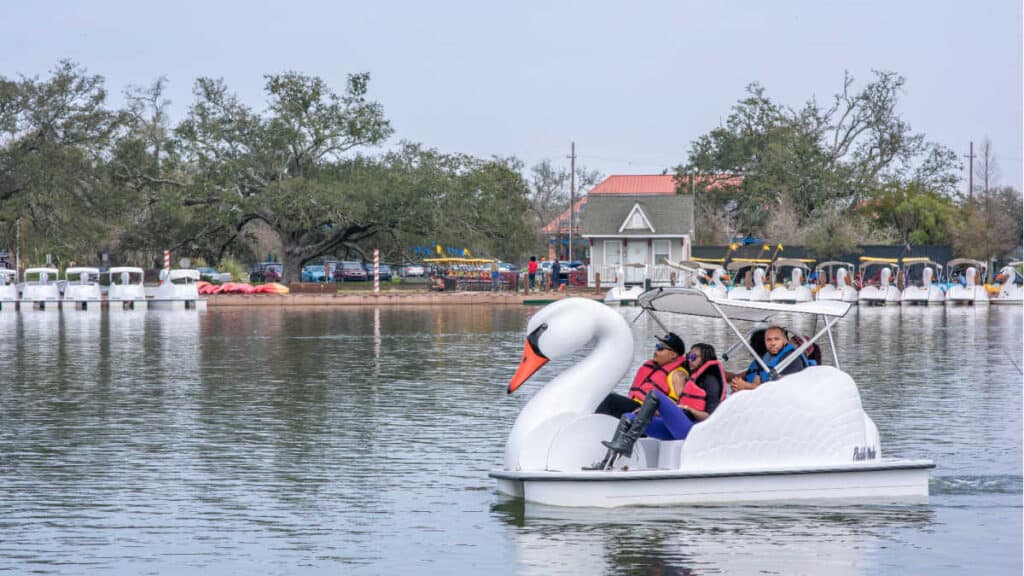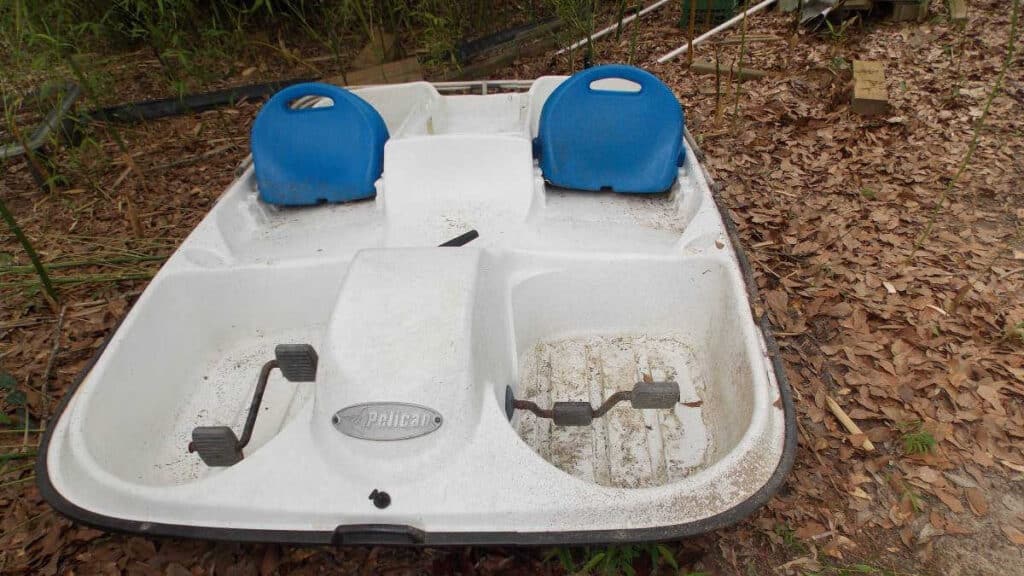As an Amazon Associate I earn from qualifying purchases.
Want to know one of the best parts about owning a pedal boat? The exercise. Pedal boating is great exercise.
Want to know one of the toughest parts of owning a pedal boat? The pedaling. It’s too much exercise. People think that pedal boats are hard to use but they really just don’t like pedaling.
While getting around on a pedal boat is fun, it can get super tiring if you’re out on the lake all day. This is even worse if you’re trying to fish from your pedal boat while you’re out.
Luckily, converting a pedal boat to electric propulsion is easily within the realm of most people and can be done in a couple of hours.
Trolling-motor-compatible pedal boats have a flat portion on the rear deck where a clamp-mount trolling motor can be added. Once the motor is in place you’ll also need to figure out a placement for the battery bank and run the wiring.
Why Would You Want A Trolling Motor On Your Pedal Boat?
Beyond the obvious (it reduces leg strain) there are several reasons why people want a trolling motor on their pedal boat.
I know that when we first got a pedal boat the pedaling was the funnest part of the first season. The next year, however, when we wanted to visit some of our favorite fishing and swimming spots, we realized just how long we’d be pedaling to get there and wanted a bit more firepower.
Our motor has given us several advantages:
- It lets us rest. Obviously. We can pedal when we want, and cruise when we don’t.
- It’s better for fishing. Our trolling motor is quieter and is easier to control the speed of. Besides, have you ever tried pedaling a boat while jigging?
- We can steer better. Pedal boats are slow to steer. In fact, they’re slow to do just about everything. Having a trolling motor allows us to direct the boat much easier.
- We can outrun storms. Luckily, we haven’t actually gotten caught in a storm but we have been on the opposite side of the lake from our car when clouds start running it. Being able to use the trolling motor in tandem with pedaling (not usually recommended) helped us make it back in time.
Now, the trolling motor we have isn’t much faster than pedaling but it does mean that we don’t have to pedal all out all the time.
Choosing The Best Trolling Motor For A Pedal Boat
Choosing a trolling motor for your pedal boat relies on two main decisions: how you will mount it and how many pounds of thrust you want.
Mounting Styles are fairly straightforward. If you have a clamp area, get a transom-mounted motor, even though your power options will be limited.
For this mounting style, I would recommend a 36lb thrust trolling motor (or similar). You’ll need to measure the shaft length to make sure you have the right one for your specific model of pedal boat. My pedal boat needed a 30″ shaft and we went with a Newport Vessels NV-36.
It pushes our boat to around 2mph which is a bit slow for our liking but it gets the job done.
If you are going to the effort of bolting a trolling motor to your pedal boat, I would recommend that you go with a motor in the 46-55lb range. While it will draw more power it will give you greater versatility. You might not need that much power all the time but most people feel that it’s better to have more than less.
I would still recommend a transom-mounted trolling motor as it will be the easiest to remove if need be.
If this is the route you’re going, check out the NV-46 which is a step above the previous motor.
Common Issues That Need To Be Solved
When you’re converting a pedal boat to electric power there are a couple of issues that need to be solved. These issues are not necessarily unique to pedal boats but are the typical issues that come with a trolling motor installation.
Here’s what you’ll need to figure out:
Motor Mounting
If your pedal boat is set up from the factory to have a motor installed, it will already have an available location.
Typically, this is a flat portion on the rear of the boat where you can easily clamp a small trolling motor.
If you don’t have this location available you are left with fabricating your own mounting position. While this is obviously a more difficult proposition it opens up the possibility of using trolling motors with different mounting styles. There are significantly more options of this type and you can get one that provides more thrust.
As long as you keep it watertight, there is no reason you can’t drill mounting points through your pedal boat. Many people buy or make a steel trolling motor mounting plate and bolt it straight through the back end of their boat.
From that point, it is simply a matter of bolting your motor in place.
Battery and Wiring
If you add an electric motor to your pedal boat you’ll also need a power source. Most small trolling motors utilize a class 27 or 29 battery. You can either get deep-cell marine batteries (the best option) or go a more budget route and get them from Walmart.
The easiest (and most aesthetic) way to deal with batteries on your pedal boat is to get a smart battery bank. This allows you to safely attach your batteries, chain them together, read voltage, charge your phone, power a fish finder, etc.
Most people with a 5-seat pedal boat choose to mount the battery on the middle seat location in the back. This allows easy access to the batteries and means that you can easily run a short stretch of wiring anywhere in the boat.
Reaching the Motor
Of the biggest issues when it comes to converting a pedal boat to electric is reaching the motor, particularly in larger boats. Electric pedal boats are typically made with a battery compartment in the middle and an easily reachable throttle.
If you install your own trolling motor the throttle and steering are typically located at the rear of the boat and can be nearly unreachable from the from. This leaves you with a few options: use a smaller boat, have someone operate the trolling motor from a back seat, or extend the controls so that could be reachable from the front seats.
Is There A Kit To Put A Trolling Motor On My Pedal Boat?
Unfortunately, there is no “all-in-one” kit on the market that will let you stick any trolling motor onto any pedal boat.
However, the way to make it easy on yourself is to pick a motor that is easy to mount on whatever boat you have. The motor we recommend above has a screw-style clamp mount that you can tighten down to pretty much any surface that it fits on.
If that is too much for you, buying a pedal boat with a factory-installed trolling motor is likely your best option.
How To Install An Electric Trolling Motor On A Pedal Boat
Converting your pedal boat to electric (while preserving the pedals) is something that is well within the reach of a backyard tinkerer.
While the steps may vary slightly depending on your model of boat and trolling motor, the steps are generally the same:
- Decide on a mounting location for the motor.
- Mockup the motor and battery locations
- Clamp or bolt the motor in place
- Secure the battery
- Run and secure the wiring
- Make sure the propeller is clear and test the motor
- Make corrections if needed
- Test your boat on the lake
- Enjoy resting your legs!
When installing a battery and trolling motor on your pedal boat be sure to follow the instructions and warning provided by the manufacturer.
The Best DIY Solution If You’re Handy
If you’re handy and don’t need the pedals, you can actually locate the motor right up front where you can operate the boat from the comfort of your seat.
While this will take a bit of elbow grease and ingenuity it can solve several of the issues that people face when adding a motor.
Check it out:
While this does free up a bunch of legroom, I’m not a fan of forgoing the pedals altogether. After all, what are you going to do when you run out of battery, paddle?
Conclusion: Is It Worth It?
So it is worth it to convert your pedal boat to electric? Honestly, for most people, no. Unless you spend the majority of your time on large lakes or use your pedal boat exclusively for fishing I’d recommend leaving your pedal boat as is and just enjoying it.
Adding a motor adds a level of complexity to your boat and also means you can’t take it out on small ponds where motorized boats aren’t allowed.
At the end of the day, adding a motor isn’t hard and, if you’re in the right situation, it can be a total game-changer.







